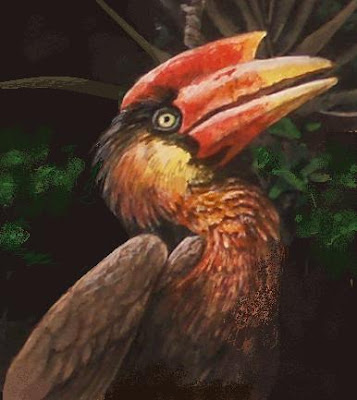UNRAVELING THE MYSTERY OF FROG DECLINE: GETTING WARMER
 As a boy I took pride in my skills at catching the Northern Leopard Frogs (Rana pipiens) that were plentiful in three ponds within a few miles of my home. In the spring of '72, I was surprised to find but a few frogs emerging from hibernation. I never saw a leopard frog in the area after 1973. A decade later, I learned that herpetologists throughout the Americas, and Australia too, had witnessed similar phenomena.
As a boy I took pride in my skills at catching the Northern Leopard Frogs (Rana pipiens) that were plentiful in three ponds within a few miles of my home. In the spring of '72, I was surprised to find but a few frogs emerging from hibernation. I never saw a leopard frog in the area after 1973. A decade later, I learned that herpetologists throughout the Americas, and Australia too, had witnessed similar phenomena.Today the continuing decline of frog species is well known, but still poorly understood. What is known, is that a panoply of factors are involved. Chemical pollutants like PCBs, organochlorides and other herbicides like Roundup and Atrazine, and insecticides like Malathion and Esfenvalerate have all been shown to kill frogs in extremely small concentrations. Acid rain has been implicated in crashes of Natterjack Toads (Bufo calamita) in Southern England and Red-legged Frogs (Rana aurora) in central California. UV radiation and the aquatic fungus Saprolegnia ferax have devastated populations of Wetern Toads (Bufo borealis) and others in the Cascade Mountains. The flatworm Ribeiroia ondatrae has exploded in numbers, causing leg deformities in many populations. Invasive plant and animal species have hurt many amphibian populations, including fellow anurans like the American Bullfrog (Rana catesbiana) and the Cane Toad (Bufo marinus). In western North America, the introduction of trout, bass, and other game fish has led to the disappearance of native amphibians from many waters. Pressure from commercial hunting for frog legs has devastated populations of the Pig Frog (Rana grylio) in the United States, the Edible Frog (R. esculenta) in Europe and R. tigrina and R. hexadactyla in India and Bangladesh.

In 1998, biologist Karen Lips was surprised to find quantities of dead frogs in her study area in Panama. Since frog corpses don’t last long in the jungle, she presumed what she saw was but a microcosm of what was actually happening. Inspection of the dead amphibians revealed that they had all been attacked by a chytrid fungus, which was christened Batrachochytrium dendrobatidis. Members of this fungal family normally subsist on decaying organic matter. This was the first known instance of one attacking living vertebrates. Within a year, researchers had isolated B. dendrobatidis from dead frogs of several species in Australia, as well as in the United States, Costa Rica, and even a number of zoos. It was also found in preserved specimens of Arroyo Toads (Bufo microscaphus californicus) from a 1991 California die-off.
Just how this fungus managed to spring up nearly simultaneously in several locations thousands of miles apart is still enigmatic, but in a paper in today's issue of the journal Nature, J. Alan Pounds and his colleagues have tied the infections to global warming.
Pounds has been studying frogs in Costa Rica's Monteverde cloud forest since the '80s, when 20 of the 50 resident frog species in his 30 km2 study area vanished within a few years. Included in this list was the famous Golden Toad (Bufo periglenes), whose sudden extinction still perplexes observers. Since that study, at least 110 subsequent frog extinctions have been linked to B. dendrobatidis, including 65 species of harlequin toads (Atelopus spp.). Pounds found that 80% of the extinctions he studied coincided with abnormally warm years, a connection he also noted in his original 1994 Conservation Biology paper. Over two decades, he has put together a weather model of daily and annual trends at Monteverde. He posits that regional warming has caused the forest's cloud bank to sit higher on the mountainside, and become denser. This density causes a narrowing of daily temperature fluctuation within the cloud forest, improving conditions for B. dendrobatidis, which prefers a range of 63º-77º F. A more pronounced wet/dry season has also been observed.

Pounds' paper provides one more insight into the complex puzzle that is the current global frog devastation. Habitat loss and fragmentation, pollution, ozone depletion and warming are all having their effect on Earth's biology. Frogs seem to take it all a bit harder. By watching what's happening to them, we can better understand the complete picture of contemporary ecological change.
___________________
upper: Dendrobates duellmani (1999) acrylic 7" x 7"
center : Emerald Toucanets & Spiny-headed Treefrog (1995) acrylic 22" x 30"
lower: Hyalinobatrachium valerioi (1999) acrylic 7" x 7"





6 Comments:
Carelie:
Shouldn't you be spending more time painting? ;-)
-S
Interesting, species of leopard frog here in Arizona have suffered severe population declines too, such as the Chiricahua Leopard Frog (Rana chiricahuensis).
S: Absolutely.
Beth: Yes, something's going on here. Major frog declines are being described in Africa, now, too.
our own frog population has been on a steady decline for the past decade.
Your paintings are exquisite!
good summation :-) I studied frogs in Oregon during undergraduate, and I'm now applying to some graduate labs that study amphibians. I went to interview at a school in Pennsylvania, and I spoke at length about my interest in amphibian conservation and the pressing problem of frog declines. Lo and behold, the prof says, "well, our frogs in PA aren't in decline. They're all doing fine." But it seems as if amphibian declines are a problem almost everywhere else in the world.
Thanks, Leah. Good luck with your applications. Did you happen to study with Andrew Blaustein at OSU?
Post a Comment
<< Home